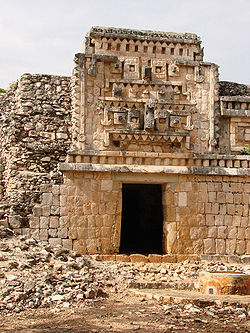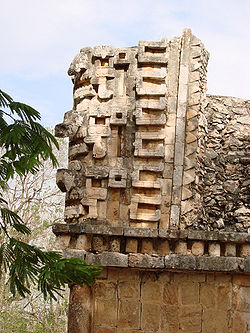
Xlapak
Encyclopedia


Maya civilization
The Maya is a Mesoamerican civilization, noted for the only known fully developed written language of the pre-Columbian Americas, as well as for its art, architecture, and mathematical and astronomical systems. Initially established during the Pre-Classic period The Maya is a Mesoamerican...
archaeological site in the Yucatan Peninsula
Yucatán Peninsula
The Yucatán Peninsula, in southeastern Mexico, separates the Caribbean Sea from the Gulf of Mexico, with the northern coastline on the Yucatán Channel...
of southeastern Mexico
Mexico
The United Mexican States , commonly known as Mexico , is a federal constitutional republic in North America. It is bordered on the north by the United States; on the south and west by the Pacific Ocean; on the southeast by Guatemala, Belize, and the Caribbean Sea; and on the east by the Gulf of...
. It is located in the heart of the Puuc
Puuc
Puuc is the name of either a region in the Mexican state of Yucatán or a Maya architectural style prevalent in that region. The word "puuc" is derived from the Maya term for "hill". Since the Yucatán is relatively flat, this term was extended to encompass the large karstic range of hills in the...
region, about 4 kilometres (2.5 mi) from the archaeological site of Labná
Labná
Labna is a Mesoamerican archaeological site and ceremonial center of the pre-Columbian Maya civilization, located in the Puuc Hills region of the Yucatán Peninsula. It is situated to the south of the large Maya site of Uxmal, in the southwest of the present-day state of Yucatán, Mexico...
and a similar distance from Sayil
Sayil
Sayil is a Maya archaeological site in the Mexican state of Yucatán, in the southwest of the state, south of Uxmal. It was incorporated together with Uxmal as a UNESCO World Heritage Site in 1996....
, lying directly between the two sites. It consists of three main groups in a valley of the Puuc Hills in Yucatán
Yucatán
Yucatán officially Estado Libre y Soberano de Yucatán is one of the 31 states which, with the Federal District, comprise the 32 Federal Entities of Mexico. It is divided in 106 municipalities and its capital city is Mérida....
State, a region of karst
KARST
Kilometer-square Area Radio Synthesis Telescope is a Chinese telescope project to which FAST is a forerunner. KARST is a set of large spherical reflectors on karst landforms, which are bowlshaped limestone sinkholes named after the Kras region in Slovenia and Northern Italy. It will consist of...
limestone
Limestone
Limestone is a sedimentary rock composed largely of the minerals calcite and aragonite, which are different crystal forms of calcium carbonate . Many limestones are composed from skeletal fragments of marine organisms such as coral or foraminifera....
forming the only major topographical
Topography
Topography is the study of Earth's surface shape and features or those ofplanets, moons, and asteroids...
feature of the peninsula. The closest town is Oxkutzcab, about 30 kilometres (18.6 mi) to the northeast.
The site dates from the Late to Terminal Classic
Mesoamerican chronology
Mesoamerican chronology divides the history of pre-Columbian Mesoamerica into several periods: the Paleo-Indian , the Archaic , the Preclassic , the Classic , and the Postclassic...
periods and was sited in an area suitable for agriculture.
Restoration at Xlapak, and other nearby archaeological sites, was carried out in the first half of the 20th century by the Mexican Instituto de Antropologia e Historia
Instituto de Antropología e Historia
The Instituto de Antropología e Historia is the national institute in Guatemala responsible for the protection and maintenance of Guatemala's historical and archaeological sites, monuments, artefacts, and other aspects of the nation's cultural heritage.IDAEH was established by governmental decree...
(Institute of Anthropology and History). Further archaeological investigation was carried out in 1965 under the direction of César A. Sáenz.
The site
The site core is located in the flat valley bottom, while in the surrounding hills the remains of perishable structures have been found.The main feature of Group 1 is the Palace, which consists of nine rooms with decorated facades. Another palace is located in Group 2, it is decorated with columns. The architecture is an example of the ostentatious style of the Classic or Florescent Puuc, in common with the nearby sites of Sayil, Labna, Kabah
Kabah (Maya site)
Kabah is a Maya archaeological site in the south-east of the Mexican state of Yucatán....
, and Uxmal
Uxmal
Uxmal was dominant from 875 to 900 CE. The site appears to have been the capital of a regional state in the Puuc region from 850-950 CE. The Maya dynasty expanded their dominion over their neighbors. This prominence didn't last long...
. Typical of this style are the highly decorated upper portions of the buildings that extend above the ceiling height. The decorations at Xlapak are well preserved and include masks of the Yucatec Maya rain god Chaac
Chaac
Chaac is the name of the Maya rain deity. With his lightning axe, Chaac strikes the clouds and produces thunder and rain. Chaac corresponds to Tlaloc among the Aztecs.-Rain deities and rain makers:...
.

